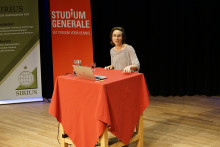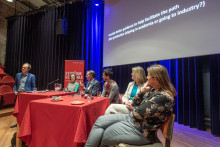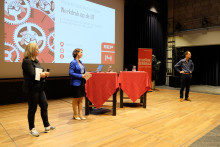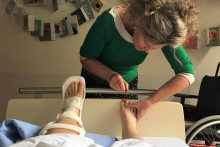‘Groundbreaking Climate Research’
Maarten van Aalst, professor of Disaster Risk Reduction at the ITC Faculty, started with the Noble prize for Physics, whose one half was jointly awarded to Sykuro Manabe and Klaus Hasselmann and the other half to Giorgio Parisi ‘for groundbreaking contribution to our understanding of complex systems’.
Van Aalst first introduced the work of Parisi. ‘Every time loose atoms are compressed, a new irregular pattern is formed, even though it is compressed in exactly the same way. Parisi focused on finding structure in this disordered system through mathematical representations. The same can be said about his spin glass theory – where a magnet, affected by other magnets around it, are frustrated about which direction to point. Much like finding social order when people don’t get along.’ The reason why Parisi’s work is so important, according to Aalst, is that his work can be generalized to different complex systems, including the Earth’s climate.
He went on to explain the work of Manabe and Hasselmann. Manabe was responsible for creating the first physical models of the Earth’s climate, which formed the basis of many climate models later on. This work was followed by Hasselmann where he showed that climate can be modelled despite its chaotic nature. The common point in their research: ‘increasing temperature of the atmosphere is the result of human emission of carbon dioxide’.
‘Why award a Nobel Prize in climate research now? Because the work of these three scholars have developed groundbreaking climate research, where we now longer can ask uncertain abstract questions about the causes of climate change, but more concrete questions in knowing the climate and what we can do to adapt’, concludes Van Aalst.
‘Receptors for temperature and touch’
Armagon Kocer, professor of Bioelectric Signaling and Engineering at the TNW faculty, was next. She talked about the Nobel Prize for Medicine which was jointly awarded to David Julius and Ardem Patapoutian, ‘for their discoveries of receptors for temperature and touch’. ‘The main goal of Julius’ research was to find out how one feels pain and this he did through the use of capsaicin – the chemical compound found in chili peppers. He did this by isolating DNA fragments of sensory neurons that are receptive to capsaicin and then introducing those fragments into cells that are not receptive until he found a receptor that responded – TRPV1.’
She then explained the work of Patapoutian, whose goal was to identify the receptors that are activated by mechanical stimuli. ‘When individual cells were poked with a pipette – a common laboratory instrument, they gave off an electric signal. After silencing each of the 72 possible genes, Papapoutian found the receptive gene in the 72nd attempt. Thank god he didn’t give up’, Kocer adds jokingly.
‘Asymmetric Organocatalysis’
Finally, Jan van Maarseveen, a professor at the University of Amsterdam, explained about the Nobel Prize for Chemistry, which was awarded jointly to Benjamin List and David MacMillian, ‘for the development of asymmetric organocatalysis’. Before starting, Maarseveen first introduced a small experiment to the audience by asking an audience member to identify the scent of two limonene bottles – (+) limonene and (-) limonene. This two compounds happen to be mirror images of one another with one having a lemon scent and the other a orange scent. ‘The fact that our body can distinguish between two very similar compounds in term of scent indicates the varying and sometimes harmful effects similar compounds with different structures can have on the body.’
The catalysts developed by List and MacMillian are able to ‘selectively produce one desired structure’ referred to as asymmetric catalysis. Prior to the research of List and MacMillian, heavy metals were widely used in catalysis. ‘Heavy metals such as Palladium and Osmium are very harmful to the environment. As chemists, we always try to steal information from nature, and organic molecules such as amino acids are far less toxic and are more sustainable.’







